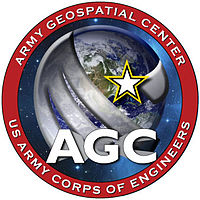Army Geospatial Center
 |
|
| Established | 2009 |
|---|---|
| Research type | Develop geospatial capabilities for the Army and the Department of Defense |
| Director | Joseph Fontanella |
| Address | 7701 Telegraph Road |
| Location | Alexandria, Virginia, U.S.A. |
|
Zip code
|
22315-3864 |
| Website | www |
The Army Geospatial Center (AGC) (formerly Topographic Engineering Center (TEC)) is a Major Subordinate Command of the United States Army Corps of Engineers. It is located in Alexandria, Virginia, within the Humphreys Engineering Center adjacent to the Fort Belvoir military reservation.
The AGC reportedly coordinates, integrates, and synchronizes geospatial information and standards across the Army, develops and fields geospatial enterprise-enabled systems and capabilities to the Army and the Department of Defense, and provides direct geospatial support and products to Warfighters. Its Geospatial Research and Engineering Division, an Engineer Research and Development Center asset, conducts research and development into geospatial data collection, processing, exploitation, and dissemination in support of both civilian missions and missions of U.S. ground forces.
AGC reportedly employs a workforce of more than 400, which includes Department of Defense civilians, contractors and military personnel. They support four program areas in support of the AGC mission:
The AGC Director serves as the Geospatial Information Officer of the US Army.
AGC's primary area of expertise is in acquiring and depicting terrain data. It has developed products to rapidly characterize complex and urban terrain that include the use of the Rapid Terrain Visualization (RTV) and Urban Recon (UR) Advanced Concept Technology Demonstrations (ACTDs). These are embodied in the BuckEye program, bringing the collection of high resolution color imagery and coincidentally collected Light Detection and Ranging (LIDAR) data to the battlefield, enabling the rapid characterization of complex and urban terrain at a human scale. Typically, the BuckEye program collects 1m post spacing terrain data (derived from LIDAR) coincidentally collected with 10 cm color imagery. BuckEye data products are reportedly unclassified and for sharing with US military allies.
BuckEye was first deployed operationally in Iraq in 2004, under Operation Iraqi Freedom, on rotary-wing aircraft. BuckEye was subsequently flown over all of Iraq’s urban areas and transportation corridors, constituting some 11% of the Iraqi landmass, using fixed-wing aircraft. BuckEye was first deployed operationally in Afghanistan in 2006, under Operation Enduring Freedom, on rotary-wing aircraft. By 2008, BuckEye was being consistently flown fixed-wing over Afghanistan. With the surge in forces beginning in 2009, multiple BuckEye fixed-wing and unmanned aircraft systems (UAS) platforms have been deployed in Afghanistan to gather human-scale terrain data for use by Coalition commanders and host nation forces. The BuckEye program was recognized as a 2006 Army "Greatest Invention of the Year."
...
Wikipedia
